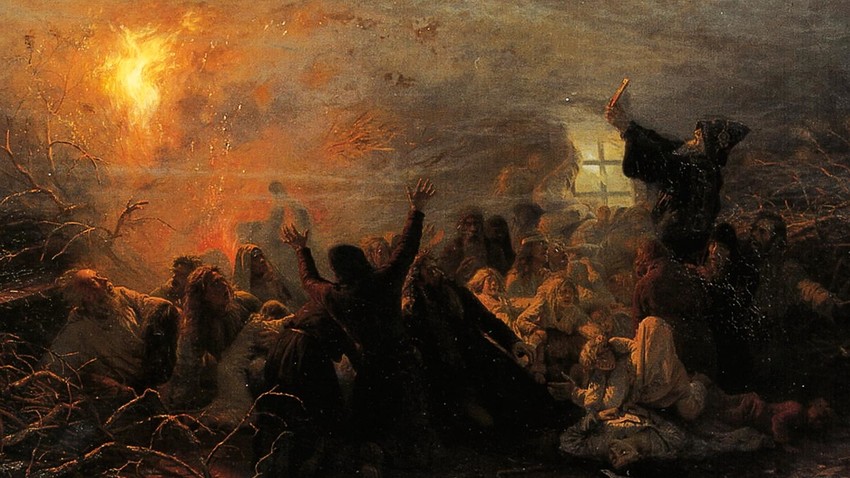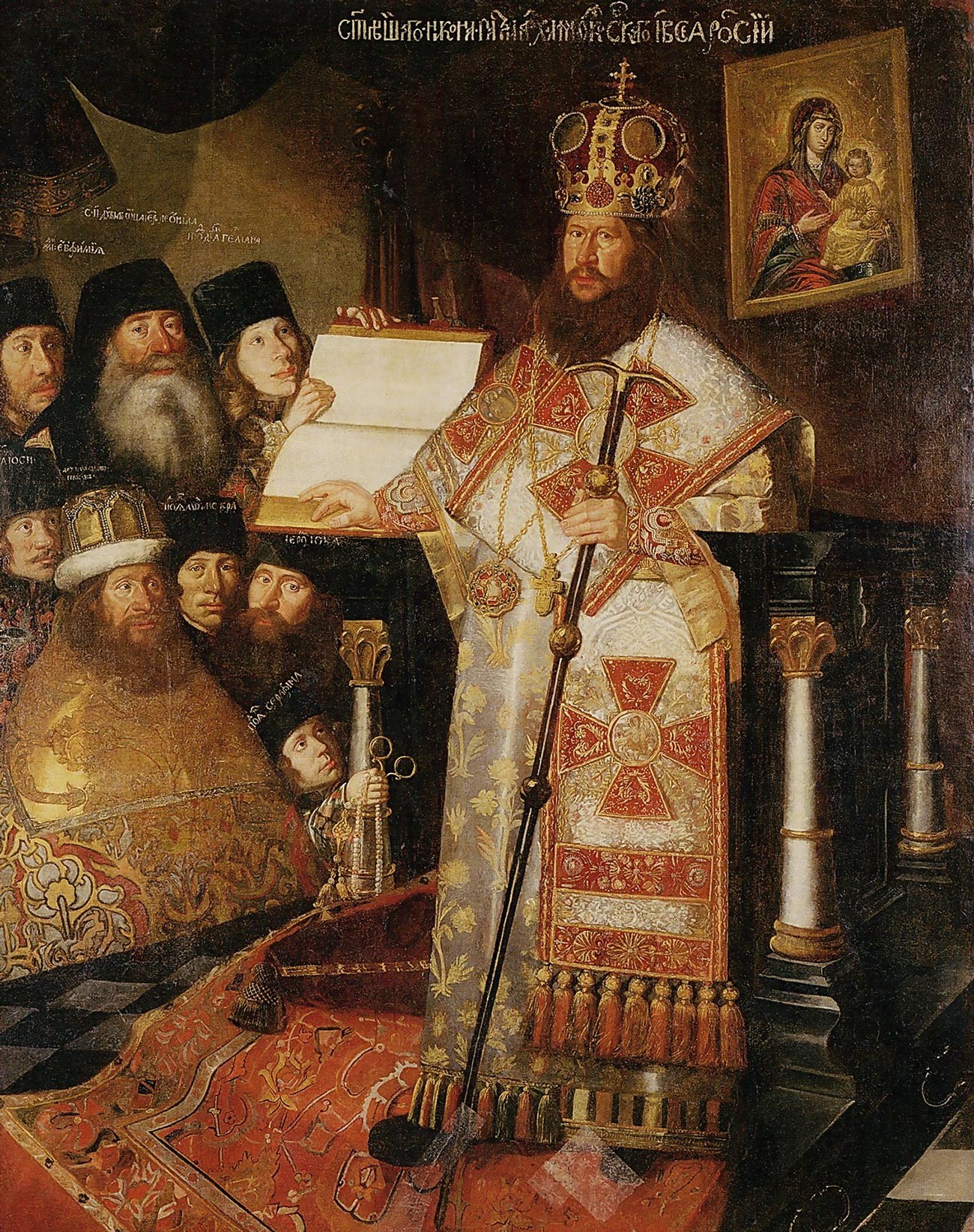The tradition of self-immolation amongst Russian ancient Believers spanned two centuries and remains a different phenomenon in contemporary history.
there have been Russian people who selected loss of life in preference to quit their faith. the cruel subculture of collective suicides by fire was born among the Russian ancient Believers in the seventeenth century and persisted into the 19th century.

"Self-Immolators," 1882, via Grigoriy Myasoyedov
Grigoriy Myasoyedov"With a heavy thud of the explosion, the floor shook and every person felt a blast of air to their chests. Smoke regarded between the cracks of the roof, after which, greater thicker smoke… The flames leapt between the logs of the hut. When soldiers burst throughout the door, a man caught in flames fell out, his head burned black. He rolled on the snow like a worm. interior the prayer apartment, smoke and fireplace changed into swirling, and burning people staggered back and forth. The fireplace became coming from the basement. [...] The soldiers took a couple of steps again because of the unbearable warmth. apparently, no person may well be saved. The soldiers crossed themselves, having taken off their three-cornered hats, some have been crying. [...] And one had nowhere to conceal from the scent of burned flesh."
here's how Alexey Tolstoy describes an episode of self-immolation in his novel "Peter the primary." The self-immolations of old Believers in Russia all started throughout the reign of Peter's father, tsar Alexey Mikhailovich (1629-1676), as a result of spiritual reforms initiated through the tsar and Patriarch Nikon (1605-1681). The self-immolations quickly gained a unique identify, гари ('gari,' singular гарь, 'gar''), which roughly capability 'burn.'
The Raskol
Patriarch Nikon (Nikita Minov)
Public domainIn 1596, the Kievan town broke off relations with the Russian Orthodox Church and entered into communion with the Pope of Rome. The Orthodox church buildings of the Polish-Lithuanian Commonwealth grew to become Greek Catholic churches. This become a harsh blow for the Russian Orthodox church that misplaced parishes, territories, and money. through the mid-seventeenth century, Russian patriarch Nikon determined to reform the Russian Orthodox church.
Patriarch Nikon invited Catholic scholars from Kiev to relevant the Russian liturgical books that had many error compared to their Greek originals – they have been copied and re-copied through Russian monks for centuries and vital updating. Historians aren't certain what became Nikon's eventual goal, probably he, too, desired the Russian Orthodox church to enter into communion with the Pope. What was crucial is that this reform led to the Raskol (the cut up) – the splitting of the Russian Orthodox Church. Two fingers raised before making the sign of the go grew to become the symbol of the Raskol. Why?

"The Boyarynia Morozova," 1887, by Vasiliy Surikov (1848-1916). Feodosia Morozova (1632 – 1675) become a noblewoman and a supporter of the historical Believer stream. here she is seen along with her two fingers raised within the historical Believers' method of constructing the sign of the move. Morozova died in penitentiary.
Vasily Surikov/Tretyakov GalleryIn 1653, letters from the Patriarch had been sent to all of the churches of Moscow, and in consequence, to all eparchies (provincial church branches) of the Muscovy Tsardom. These letters introduced new suggestions of liturgical features, and new, corrected liturgical books have been printed and dispensed within the nation. Nikon used the reform to enhance his authority because the head of the renewed Russian church.
among the most essential liturgical alterations, the two-fingered sign of the cross changed into changed to a 3-fingered one, the identify of Jesus modified its spelling on icons, etc. For contemporary americans, these adjustments might seem to be minor, however in the seventeenth century, they had been crucial.
these Russian Orthodox Christians who denied the reform as "devilish," because Nikon's adjustments messed with the most sacred symbols of religion, have been called the historical Ritualists, or, commonly, the old Believers. They have been anathematized on the great Moscow Synod of 1666 – this meant that these americans may not take part in legit Russian Orthodox sacraments. additionally, they were double-taxed, banned from gatherings and organizing chapels. These actions of the official church have been met by using the old Believers with the cruelest response one could think about, collective self-immolations.
The conclusion of Days
"The awesome Comet of 1680," by a Dutch artist Lieve Verschuier (1627-1686)
Lieve Verschuier/Museum RotterdamFor the ancient Believers, it became no coincidence that they had been anathematized in 1666. despite the fact they counted their years from the advent of the world, they were aware about the incontrovertible fact that within the Julian calendar, this year turned into marked by the satan's quantity. The ancient Believers basically noticed this as a dark omen. however wasn't the only 1.
"Cyril's publication" become a compendium of religious texts, standard within the seventeenth century. It contained predictions concerning the conclusion of Days that could take place "right through the 8th millennium from Adam" (6999/7000 from Adam came in 1492 ad; 1666 ad changed into 7173/7174 from Adam). It additionally observed the Pope became the predecessor of the Antichrist who would rule in Jerusalem – and extremely appropriately, Nikon known as his new church grounds close Moscow "the new Jerusalem."

the new Jerusalem Monastery's leading Cathedral of the Resurrection. the brand new Jerusalem monastery close Moscow changed into situated by using Patriarch Nikon and in brief served as his dwelling.
Fyodor AlekseyevIn 1654, a devastating plague epidemic struck Russia, killing up to 800,000 individuals. within the center of it, the solar eclipse of August 1654 happened, extra proving the "end of the world" as nigh. finally, the high-quality Comet of 1680 appeared in the skies, as if quoting Revelation 9:1: "The fifth angel sounded his trumpet, and i saw a celeb that had fallen from the sky to the earth. The celebrity changed into given the important thing to the shaft of the Abyss." It stayed within the sky from November 1680 to February 1681. can you even think about how terrified the historical Believers (as well as all different Russians) had been? Even Patriarch Nikon himself later recalled the photo voltaic eclipse amidst the plague struck him bloodless to the marrow. individuals were satisfied that the realm changed into ending. In 1666, the primary self-immolation of the ancient Believers came about in the Nizhny Novgorod region. And there have been dozens greater to come back.
'Baptism by means of fire'
'Bishop Paul of Kolomna being burned,' a 19th-century ancient Ritualists' graphic. Paul of Kolomna (Павел Коломенский) become a seventeenth-century Russian prelate and martyr within the view of the historical Believers.
Public areaMarch 1666, Vologda location: 17 people self-immolated. 1672, Nizhny Novgorod – 2,000 people. 1675, Vologda vicinity – one more 2,000. In 1678, the Paleostrov self-immolation, one of the crucial biggest, took over 2,700 individuals on the sight of soldiers and officers who had been despatched to cease the burnings. In total in Russian heritage, there were over one hundred officially registered self-immolations of the ancient Believers.
in addition, in 1685 the Moscow government led via Sophia Alekseyevna of Russia (1657-1704) introduced execution via burning for those old Believers who refused to hand over their beliefs. earlier in 1682, Avvakum Petrov (1620-1682), the chief of the Russian historic Believers and their revered saint, became burned alive in a log cabin in Pustozersk, Arkhangelsk region, in opposition t his will. This law and this appalling deed best whipped up the self-immolations that had been already in full swing by the time.
The historical Believers regarded this no longer to be a suicide – this changed into a martyr's dying as an act of protest against the anti-Christian civil powers and the corrupt church, as the old Believers put it. They didn't self-immolate 'via themselves' – the operation became often performed as a response to forcible conversion to the Russian Orthodox (now, Nikonian) faith, which the historic Believers considered unholy and lewd.

Avvakum Petrov on a 17th-century old Ritualists' icon
State old MuseumThe self-immolation became completely prepared – beneath the supervision of one of the ancient Believer tutors (they didn't have monks), a "burn condo" became developed – an enormous wooden structure that might contain the self-immolators. as an instance, a 'burn condo' in-built the Arkhangelsk area for the 1685 self-immolation contained 230 our bodies. It wasn't usually a single-room house, more like several wooden cabins joined together, often in two or greater storeys. regular 'burn houses' have been meant for a number of dozen individuals.
The condo turned into then filled with hay, candle tow, and different flammable substances, including commonly a barrel or two of gunpowder. The home windows and the door had been able to be sealed from the backyard via other historical Believers who have been to aide the self-immolators. As soon because the historical Believers discovered about any militia formation heading their manner, they locked themselves internal the building and waited for the soldiers to return, then self-immolated.
before self-immolation, all historical Believers and their babies were symbolically christened once more, as a result of they had been to face 'baptism with fire'. a lot of them took monastic vows. however no longer all of them were so brave to withstand the fire. internal the 'burn condominium', certain relied on people (that were to burn with the others, too) were armed with rifles and axes to homicide those who tried to escape – one should settle for the 'fireplace baptism' with humility, because it became a door to everlasting life in the Kingdom of God, the historical Believers preached. Anyway, demise for these terrible historic Believers got here relatively soon, now not from burns, but carbon monoxide poisoning.

loss of life of Avvakum, a 19th-century historical Ritualists' icon
Public domainregularly, because the self-immolation begun, a tutor would ascend the roof of the building and skim a sermon before crashing down into the hearth to die; written sermons have been additionally frequently thrown out of the burning house. For historical Believers, who had been banned and anathematized, this changed into the best manner of communicating with the authorities.
Most self-immolations couldn't be stopped even by means of troopers. They persevered within the 18th century and didn't stop even after the persecution of historical Believers turned into banned with the aid of Catherine the great in 1762. Between 1762-1825, 23 self-immolations were registered. probably the most very closing of them took place as late as 1941 in the Tuva place, the place local historic Believers took WWII for yet another end of the realm.
this article is written with a deep recognize for the ethical code and the history of Russian historic Ritualists and is supposed for informational functions most effective. The historic Believers are thoroughly referred to as the historic Ritualists, but are more suitable established in English, and recognized by using English language search engines like google and yahoo, through that identify.
If the usage of any of Russia past's content, partly or in full, always give an lively hyperlink to the common fabric.
No comments:
Post a Comment